Would you like to know whether it'll be sunny during your dream holiday? Or whether your tropical island will be submerged by the waves before you get there? I'm afraid this page doesn't answer either question, but it will give you some links to pages about climate science and policy.
Launch the Java Climate Model JCM5
to see Aviation's impact on Climate, from emissions to impacts, within a context of flexible multi-gas stabilisation scenarios, and explore the sensitivity to options / uncertainties
( see JCM5 main page for more info)
older Java Climate Model JCM4 also on ChooseClimate website
Plots of regional emissions, percapita emissions, the global carbon cycle, radiative forcing and temperature are all linked and you can adjust the parameters instantly just by dragging a control with you mouse.
Much more sophisticated than the map on this "flying" site! Please try it for yourself.
The remainder of this page is rather old (from 1999), and will be upated soon
Climate Science: trends, cycles and feedbacks
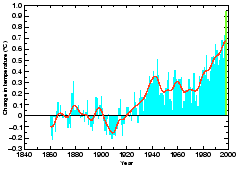 After the warmest decade for at least a millenium, there is now little doubt that greenhouse gases are warming the planet. The plot shows the global temperature rise over the last 150 years: note the green bar for 1998!
After the warmest decade for at least a millenium, there is now little doubt that greenhouse gases are warming the planet. The plot shows the global temperature rise over the last 150 years: note the green bar for 1998!
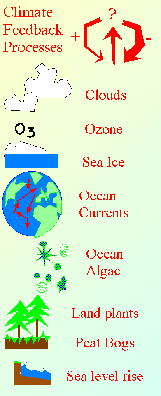 There is also a very good correlation between greenhouse gas concentrations and global temperature over the last 200,000 years, recorded by analysing air bubbles in polar ice caps. However these show that warming can occur extremely suddenly, not gradually as predicted by most current Global Climate Models. This must be due to biogeochemical climate feedbacks -processes involving ocean algae, forests and peat bogs and their production or absorption of greenhouse gases, which are particularly hard to predict and therefore of great concern. Click for a bigger picture with more detail.
There is also a very good correlation between greenhouse gas concentrations and global temperature over the last 200,000 years, recorded by analysing air bubbles in polar ice caps. However these show that warming can occur extremely suddenly, not gradually as predicted by most current Global Climate Models. This must be due to biogeochemical climate feedbacks -processes involving ocean algae, forests and peat bogs and their production or absorption of greenhouse gases, which are particularly hard to predict and therefore of great concern. Click for a bigger picture with more detail.
There are already many good web pages introducing the science of the greenhouse effect and the latest news about global warming. So rather than reinventing this wheel here, a few links are provided below to get you started. See also the links page.
Global Climate Policy
As you might have gathered even from the few calculations on this page (try "put this in a global context"), to "stabilise atmospheric concentrations of greenhouse gases at a level which would prevent dangerous anthropogenic interference in the climate system" (The aim of the UN Climate Convention) requires very substantial reductions of emissions, particularly of CO2, whose production from fossil fuel drives the economies of the world.
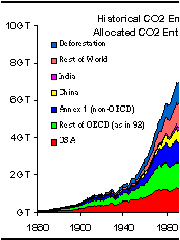
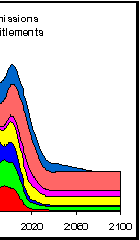 Any effective agreement must include all countries, but this will only be possible if the distribution of emission rights or quotas is equitable. The Global Commons Institute has been leading the way in developing a global equitable solution -known as "contraction and convergence" -which is based on clear principles and formulae, but is nevertheless flexible as shown by this graphic! You can now experiment with the parameters online using the linked interactive Contraction and Convergence graphics on this site.
Any effective agreement must include all countries, but this will only be possible if the distribution of emission rights or quotas is equitable. The Global Commons Institute has been leading the way in developing a global equitable solution -known as "contraction and convergence" -which is based on clear principles and formulae, but is nevertheless flexible as shown by this graphic! You can now experiment with the parameters online using the linked interactive Contraction and Convergence graphics on this site.
Other climate policy links will be added soon.
A global referendum on climate change?

At present neither most politicians nor most academics dare to answer the critical questions-how much CO2 and other greenhouse gases should we emit in total, in the long-term, and how shall we share out this limited emissions budget between all people around the world. Instead of addressing these long-term global issues with clear principles, these two groups tend to pass the buck back to each other and focus instead on the niggly procedural details of implementing the short-term, sub-global, and ineffective Kyoto protcol. Therefore I would like to bypass the "climate elite" and propose instead a global referendum on climate change, facilitated using the internet -it could also be the first example of true democracy at a global scale. I have put a document of initial ideas on the web, and your thoughts on this would be very welcome (see contact info).
Technical Fixes and Climate Engineering
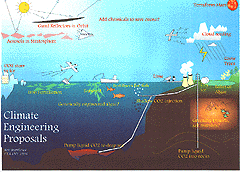 In the past many pollution problems have been alleviated by cleaning exhaust gases, but in the case of CO2 this is not thermodynamically feasible: we have to produce CO2 to get the energy from fossil fuel. Nevertheless engineers like to propose global scale "technical fixes", such as pumping the CO2 to the bottom of the ocean or fertilising the ocean algae. Others have proposed offsetting greenhouse warming by, for example, putting dust in the stratosphere.
Here is a critical review of such "climate engineering" proposals.
In the past many pollution problems have been alleviated by cleaning exhaust gases, but in the case of CO2 this is not thermodynamically feasible: we have to produce CO2 to get the energy from fossil fuel. Nevertheless engineers like to propose global scale "technical fixes", such as pumping the CO2 to the bottom of the ocean or fertilising the ocean algae. Others have proposed offsetting greenhouse warming by, for example, putting dust in the stratosphere.
Here is a critical review of such "climate engineering" proposals.
 On the other hand, there already exist many small-scale green technologies for producing renewable energy or using it more efficiently. It is a pity that these do not receive more attention.
On the other hand, there already exist many small-scale green technologies for producing renewable energy or using it more efficiently. It is a pity that these do not receive more attention.
Unfortunately, unlike trains or even a few cars, there are no electric aircraft that can run from solar, wind or wave power. Moreover, although the efficiency of aircraft has improved greatly over the last few decades, experts reckon that there is little scope for further major breakthroughs. Hydrogen-fuelled aircraft have been proposed: -these would still produce water vapour and contrails but not CO2, if the hydrogen came from a renewable source. However this is still in the distant future. The only solution is to change our lifestyles, to travel less or to travel more slowly, overland or by sea. Solving global problems requires global communication, but the internet can be just as effective as flying to conferences.
 There is also a very good correlation between greenhouse gas concentrations and global temperature over the last 200,000 years, recorded by analysing air bubbles in polar ice caps. However these show that warming can occur extremely suddenly, not gradually as predicted by most current Global Climate Models. This must be due to biogeochemical climate feedbacks -processes involving ocean algae, forests and peat bogs and their production or absorption of greenhouse gases, which are particularly hard to predict and therefore of great concern. Click for a bigger picture with more detail.
There is also a very good correlation between greenhouse gas concentrations and global temperature over the last 200,000 years, recorded by analysing air bubbles in polar ice caps. However these show that warming can occur extremely suddenly, not gradually as predicted by most current Global Climate Models. This must be due to biogeochemical climate feedbacks -processes involving ocean algae, forests and peat bogs and their production or absorption of greenhouse gases, which are particularly hard to predict and therefore of great concern. Click for a bigger picture with more detail.
 After the warmest decade for at least a millenium, there is now little doubt that greenhouse gases are warming the planet. The plot shows the global temperature rise over the last 150 years: note the green bar for 1998!
After the warmest decade for at least a millenium, there is now little doubt that greenhouse gases are warming the planet. The plot shows the global temperature rise over the last 150 years: note the green bar for 1998!



 In the past many pollution problems have been alleviated by cleaning exhaust gases, but in the case of CO2 this is not thermodynamically feasible: we have to produce CO2 to get the energy from fossil fuel. Nevertheless engineers like to propose global scale "technical fixes", such as pumping the CO2 to the bottom of the ocean or fertilising the ocean algae. Others have proposed offsetting greenhouse warming by, for example, putting dust in the stratosphere.
Here is a critical review of such "climate engineering" proposals.
In the past many pollution problems have been alleviated by cleaning exhaust gases, but in the case of CO2 this is not thermodynamically feasible: we have to produce CO2 to get the energy from fossil fuel. Nevertheless engineers like to propose global scale "technical fixes", such as pumping the CO2 to the bottom of the ocean or fertilising the ocean algae. Others have proposed offsetting greenhouse warming by, for example, putting dust in the stratosphere.
Here is a critical review of such "climate engineering" proposals.
 On the other hand, there already exist many small-scale green technologies for producing renewable energy or using it more efficiently. It is a pity that these do not receive more attention.
On the other hand, there already exist many small-scale green technologies for producing renewable energy or using it more efficiently. It is a pity that these do not receive more attention.